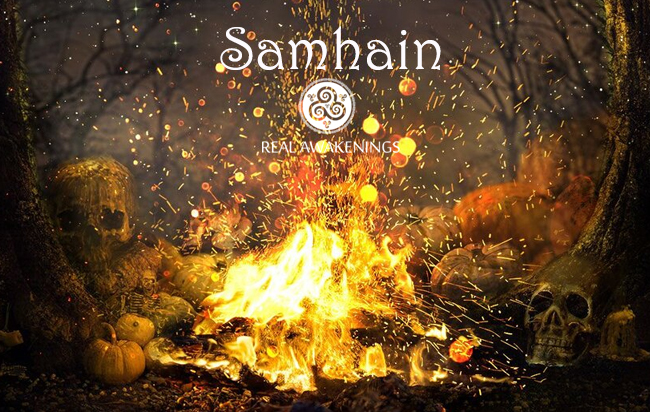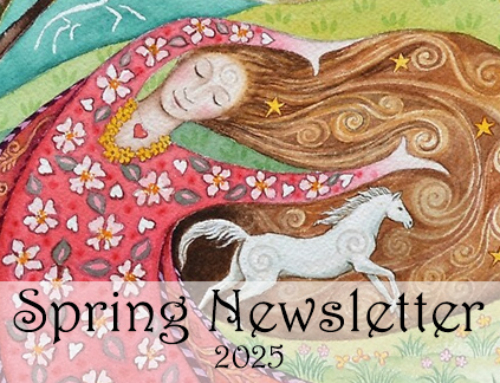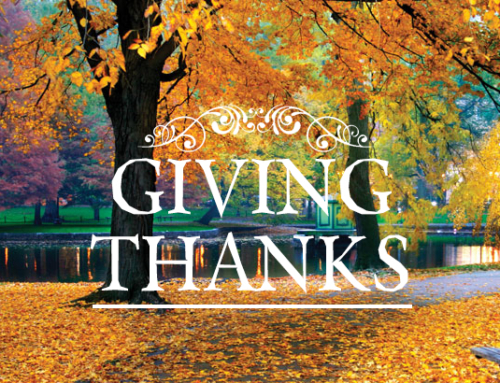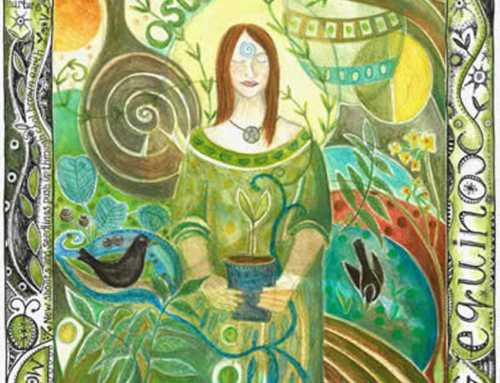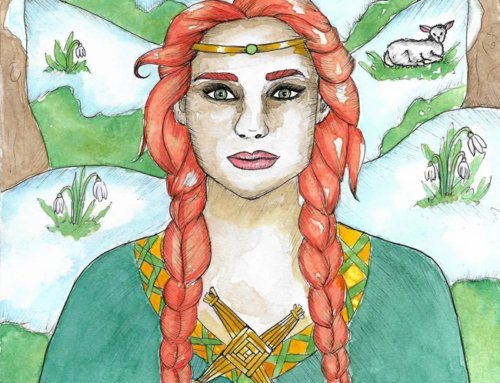The Festival of Samhain
Where the veil is thin
Purpose
According to National Geographic, the Rathcroghan territory of Ireland is a complex of over 200 archeological sites dating back before recorded history. Within this region lies a cave called Oweynagat, thought to be a portal to the lower world, and where the Celtic festival Samhain emerged 2,000 years ago. Three other fire festivals were celebrated there as well; Imbolc, Beltane and Lughnasadh.
In Gaelic, “samhraidhreadh” means “summer’s end”, and in Irish “Samhain” means the month of November. So Nov 1st is the Celtic New Year, marking the entrance into the annual dark half. The loss of green, and the dark of winter approaches. Samhain is a liminal holiday occurring midpoint between Autumn Equinox and Winter Solstice. The veil between the physical and spirit world is at its thinnest, allowing for easy access into the Otherworld; known as Tir na nnOg. We find many liminal spaces in nature such as dawn, dusk, mist, trees, shorelines, and wells. Higher tides during Samhain made for a larger portal or a thinner veil to the Otherworld.
Samhain marks the third and final harvest of the year, preparation for survival of a long hard winter, and the looming possibility of death. Herds were thinned, and meat was salted and stored for the cold months ahead. Taking their ancestry seriously, the Celtics revered the entire cycle of life including the living, the departed, and those yet to be born. The ancestors wandering about freely at this time were welcomed back into the physical world to strengthen a family lineage.
Evolution by Christians
In 835 early Christians honored their saints during Lemuria on May 13. In an attempt to join the two cultures, and eliminate Samhain, it was moved to Nov 1st and renamed All Saints Day, All Hallow’s Day or Hallowmass. In the 10th century, All Souls Day was standardized to occur on Nov 2 to specifically honor departed souls and ancestors. So Oct 31st or the Eve of Hallowmass became All Hollow’s Eve, or Halloween; the start of a 3 day marathon of deceased spirits, and saints. Occurring at the same time, is Mexico’s and Latin America’s Day of the Dead festival with far less ghoulish imagery with painted sugar skulls. Although skeletons, spirits, death, and ancestors have been associated with these days throughout history, how did Halloween end up with such spooky customs?
Modern Symbols from an Ancient History
Ghosts, Costumes & Masks
Mingling with spirits of ancestors wasn’t all fun and games. Ancestors were both feared and revered. If you didn’t bring honor to your lineage and shamed the ancestors in any way during the year they may not look at you so favorably. One’s actions not only reflected those of the past, but also set the stage for future generations.
There was fear around the possibility of meeting up with unsavory spirits, or one from someone who died the previous year that now seeks a living body to occupy. Cernunnos may also materialize to steal a child’s youthful energy so wearing costumes or masks protected a person the invisibility required to walk freely among the spirits. Similarly, escorting spirits back to their graves in the morning was easier in costume for spirits were more likely to follow a ghost. The Civil War left an abundance of unaccounted deceased souls. So, that combined that with lingering tales of the boogie man from Irish and Scottish lore, fused the theme of ghosts and goblins into Halloween iconography.
Trick or treat
During Samhain, you could also be visited by the fair folk, so treats were left on front porches to appease spirits, and avoid mischief. The church stated that trapped souls in purgatory could be released through prayer. So on All souls day, Medieval Christians, typically the poor or children, would go door to door “Souling” or taking treats of spiced cakes or money in exchange for prayers for departed. By the 1800’s intoxicated beggars continued the practice with more destructive pranks played upon those who didn’t participate, and hid their identity with costumes and masks. Another custom was for the pranksters to steal the gates from people’s fences thought to represent portals to the Otherworld. The next day the gates were returned to their rightful owners in exchange for treats.
Bon fires, Candles & Bats
Fire festivals included bonfires, feasts, games, ritual offerings and sacrifices. Ancient Druids would build their bonfires with sacred oak trees. These fires were originally called “bone fires” because after feasting, people threw their residual meat bones into the fire as an offering. The ashes were later spread over the fields to protect and bless the land for next year’s crop. Each household in the community had their own fire, and if left to extinguish, would later rekindle it with fragments of the bone fire, thereby preserving a sense of unity within the village. Another theory for letting their fires die out is that spirits considered your abode unwelcoming without any visible light. Being vulnerable during Samhain, villagers felt the bon fires also prevented them from being dragged into the Otherworld against their will. People congregated around the bon fires telling stories, which we later tagged as ghost stories. The light of the fires attracted the insects of the night, which in turn attracted bats. Somehow the natural occurrence stuck with the lore of Samhain. Eventually, bon fires were replaced by lighting candles in windows to guide the wandering ancestors back to their family homes. Legend states that a flickering candle flame on Samhain night meant it was being touched by an ancestor.
Pumpkins & Jack O’Lanterns
The name Jack O’Lantern (Jack of the Lantern) comes from an old Irish tale of Jack, a local drunk who tricked the devil to go up into a tree. But while the devil was busy picking fruit, Jack carved a cross in the tree trunk, trapping the devil there. So Jack struck a deal with the devil that if he let him down, he wouldn’t take Jack’s soul. But when Jack died, he wasn’t allowed into either heaven or hell. Jack begged to be let into hell, but the devil just threw him a lump of burning coal. Jack carried the coal in a hollowed out turnip to light his way as he wandered in the dark between heaven and hell. In the 1840’s Irish immigrants brought the legend of Jack and his lantern to America when escaping the potato famine. Pumpkins were plentiful, and easier to hollow out, making them the perfect substitute for turnips.
Apples
At the time when the Romans conquered the Celtic territories they worshiped Pomona, the goddess of fruit and trees. The Roman harvest holiday, including apples, was melded into Samhain. Throughout Europe, apples were also seen as a gateway or an omen for love interests. Taking hold in England, the tradition of bobbing for apples arrived in America with the early colonists. Customarily when bobbing for apples, the first woman to bite an apple floating in a barrel of water was the next to be married. If she placed the bitten apple under her pillow that night, her future soul mate would appear in her dreams.
Witches, cats, cauldrons and brooms.
The word “Witch” comes from “Wicca” meaning “wise one.” A witch was once an honored wise woman who could heal and commune with the spirit world. They were the herbalist and healers in the community and highly revered. The Welsh goddess Ceridwen, invoked during Samhain, is the magical crone of deep mystical wisdom, transformation, and prophecy. The cauldron is her most prominent symbol, representing the womb of the Goddess, and the Divine Feminine.
By the late Middle Ages, witches posed a threat to the establishment, and were considered in the same league as Satan. One hundred years later during the Salem witch trials, the accused witches were dunked like apples, and burned at the steak. Cats, especially black ones, were believed to contain the spirit of a deceased person, and a witch’s spirit companion. Other household items associated with witches such as her broom, potion bottles, and hat became followed suit becoming Halloween icons.
Shamanic significance
As it gets colder and darker outside, we can interpret this time of year as a call to go inside ourselves to seek the dark, and shadowy spaces we normally avoid. It’s a time to do our internal work, knowing that all things new and organized arise from the chaos of the void. We participate in Samhain by going underground.
We can use the symbols of death during Samhain to our advantage, and figure out what to extinguish or discard what’s either bothering us, traumatized us, or no that longer serves our highest good. The Celts knew that anything that doesn’t die is left to fester and rot if not totally extinguished. This is the real reason why this idea is used so much in energy work like shamanism. We want to release toxic dead energies so they don’t cause harm or disease. This process or shamanic ordeal must be a spiritual sacrifice, a struggle, or the dark night of the soul in order to reap the rewards bestowed at the Winter Solstice (the promise of a return to the light, dancing, joy and festivities). It’s similar to the tale of the Burning of Tara where we have to confront the fiery monster.
We can also look at the relationship we have with our ancestors to resolve any lingering issues residing within us as we encourage them to break free from their bondage. Samhain can also be used as a space to transmute psychic darts from the collective into a higher vibration, and transcend some of our deepest fears. Like the witch’s cauldron, it’s a time to retreat into to the dark void to stir, brew, and create what we wish to emerge next spring.
Blessed Samhain
